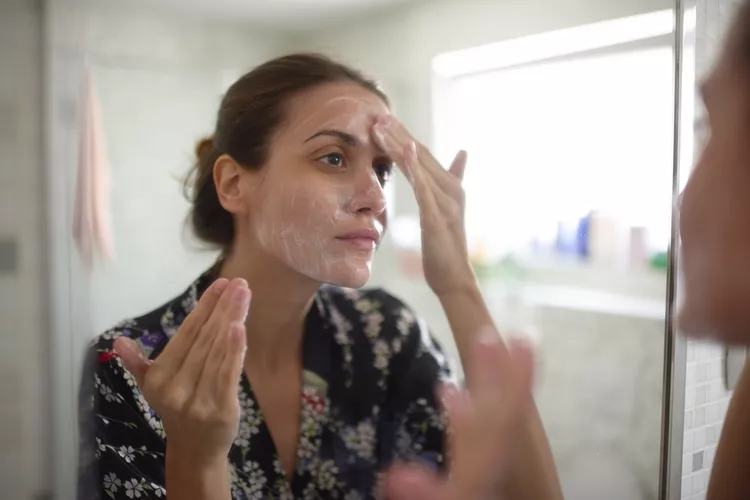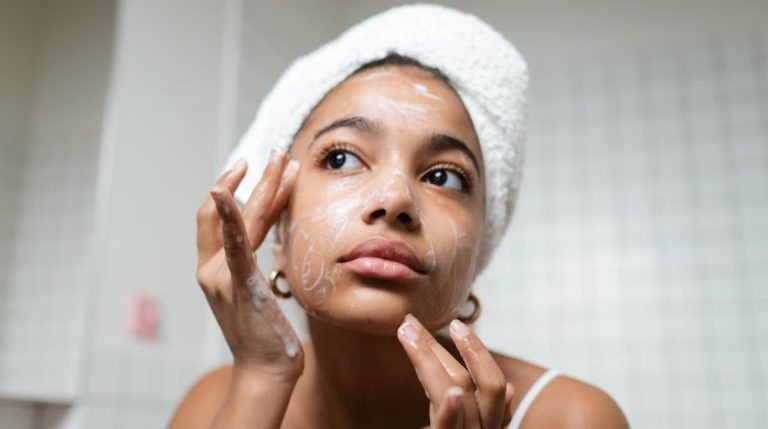Add 2 tbsp to your bedtime routine…
Having a skincare regimen involves more than just washing your face—it entails hydrating your skin, addressing any specific concerns, and shielding it from environmental factors. At its core, a basic skincare routine should incorporate cleansing, moisturizing, and sun protection. Depending on your skin type and goals, you can introduce additional treatments tailored to address dryness, oiliness, signs of aging, or acne. Here’s how to craft an optimal morning and nighttime skincare regimen that suits your skin.
Morning Skincare Routine
Your morning routine sets the stage for the day by eliminating overnight buildup and replenishing moisture while safeguarding against UV rays and pollution. Here’s how to customize your regimen according to your skin type.
Step 1: Cleanser
A morning cleanse removes excess oil and impurities that can congest pores and trigger breakouts. Opt for a mild, alcohol-free cleanser to avoid stripping essential oils needed for a healthy skin barrier. Dry skin may benefit from a hydrating oil-based cleanser. Use lukewarm water to wash your face, gently massaging the cleanser in with your fingertips before rinsing and patting dry.
Skin Type Considerations: Cleansers containing ceramides, glycerin, or hyaluronic acid are ideal for hydrating dry skin, while those with benzoyl peroxide or salicylic acid help manage excess oil and acne.
Step 2: Toner
Though optional in the morning, toners can hydrate the skin or eliminate residual grime after cleansing. Individuals with dry or acne-prone skin may find toning beneficial. Apply toner with a cotton pad or splash it directly onto your face, focusing on oily areas like the forehead, nose, and chin for those prone to acne.
Skin Type Considerations: Hyaluronic acid or rose water toners suit dry skin, while salicylic acid or witch hazel toners are suitable for oily or acne-prone skin.
Step 3: Spot Treatments or Acne Treatments
If managing acne, apply spot treatments after cleansing or toning. For those combating dark spots, opt for skin-brightening treatments. These spot treatments are targeted and can be used as required.
Skin Type Considerations: Benzoyl peroxide and salicylic acid are effective for acne treatment, while hydroquinone or kojic acid can fade dark spots.
Step 4: Antioxidant Serum
A morning serum can brighten, moisturize, and shield the skin. Serums containing antioxidants like vitamin C, E, or niacinamide combat environmental and UV damage effectively. Gently pat the serum onto your face and neck for optimal absorption.
Skin Type Considerations: Vitamin C is versatile and suits all skin types, while vitamin E and hyaluronic acid serums hydrate dry skin. Niacinamide is suitable for oily skin and can also address acne and oiliness.
Step 5: Eye Cream
While optional, eye creams hydrate the delicate undereye area. Choose products containing peptides, vitamin C, or SPF for daytime use to protect against sun damage.
Skin Type Considerations: Caffeine-infused eye creams can reduce puffiness and dark circles, ideal for tired-looking eyes.
Step 6: Moisturizer
Applying moisturizer maintains skin hydration throughout the day, essential for all skin types to balance oil production and prevent overproduction. Opt for ceramide-rich moisturizers for dry skin and lightweight, oil-free formulas for oily skin.
Skin Type Considerations: Moisturizers containing hyaluronic acid suit acne-prone, oily skin, while rich formulations with shea butter cater to dry skin.
Step 7: Sunscreen
Finish your morning routine with sunscreen to shield against UV rays, reducing the risk of skin cancer and premature aging. Choose a broad-spectrum SPF 30 or higher and reapply every two hours.
Evening Skincare Routine
Your nighttime routine focuses on removing impurities accumulated throughout the day, restoring moisture, and treating specific skin concerns. Here’s how to tailor your regimen accordingly.
Step 1: Cleanser
Nighttime cleansing eliminates dirt and oil buildup from the day. Use the same gentle cleanser as in the morning, considering a double cleanse if wearing makeup.
Skin Type Considerations: Oily skin benefits from oil-free makeup removers, while sensitive or dry skin may prefer hydrating cleansing balms.
Step 2: Toner
While optional, nighttime toning can hydrate dry skin or remove residual impurities. Consider using exfoliating toners once or twice a week to unclog pores and remove dead skin cells.
Skin Type Considerations: Hyaluronic acid or rose water toners hydrate dry skin, while salicylic acid toners suit oily or acne-prone skin.
Step 3: Spot Treatment
Continue spot treatments as needed to combat acne or fade dark spots. Avoid combining serums or retinol treatments with spot treatments to prevent irritation.
Skin Type Considerations: Alternate between spot treatments, serums, and retinol to prevent irritation, using hydrocolloid patches to treat open pimples.
Step 4: Serums or Acne Treatments
Optional nighttime serums or acne treatments can address acne and fine lines. Avoid using multiple active ingredients simultaneously to prevent irritation.
Skin Type Considerations: Dry skin benefits from hydrating serums, while AHAs like glycolic acid suit oily or combination skin, treating blackheads and pimples.
Step 5: Retinol
Retinoids stimulate cell turnover and collagen production, ideal for treating acne and fine lines. Start with a pea-sized amount every other night, gradually increasing frequency.
Skin Type Considerations: Over-the-counter retinol suits mild acne or sensitive skin, while prescription-strength retinoids address severe acne and signs of aging.
Step 6: Eye Cream
Apply a nourishing eye cream to hydrate and reduce fine lines. Look for ingredients like retinol or hyaluronic acid, avoiding irritants for sensitive skin.
Skin Type Considerations: Retinol may be too harsh for sensitive skin, so opt for gentler alternatives like hyaluronic acid.
Step 7: Moisturizer or Night Cream
Moisturize your skin with a night cream or your usual moisturizer to replenish lost moisture and aid nighttime repair processes.
Skin Type Considerations: Hyaluronic acid and glycerin-rich night creams suit dry skin, while non-comedogenic formulations are ideal for oily or combination skin.
Step 8: Face Oil
Face oils provide additional moisture and hydration, particularly beneficial for dry skin. Choose lightweight oils like jojoba for oily skin to regulate oil production without clogging pores.
Skin Type Considerations: Argan or coconut oil suits dry skin, while chamomile or rosehip oil soothes sensitive skin.
Determining Your Skin Type
Identifying your skin type—normal, dry, oily, combination, or sensitive—helps tailor your skincare routine effectively. Normal skin is balanced, dry skin lacks hydration, oily skin produces excess oil, combination skin features both dry and oily areas, and sensitive skin is easily irritated.
Additional Tips and Considerations
When layering skincare products, avoid combining AHAs or BHAs with retinol to prevent irritation. Exfoliate a few times weekly, alternating between serums and treatments. Incorporate face masks as



